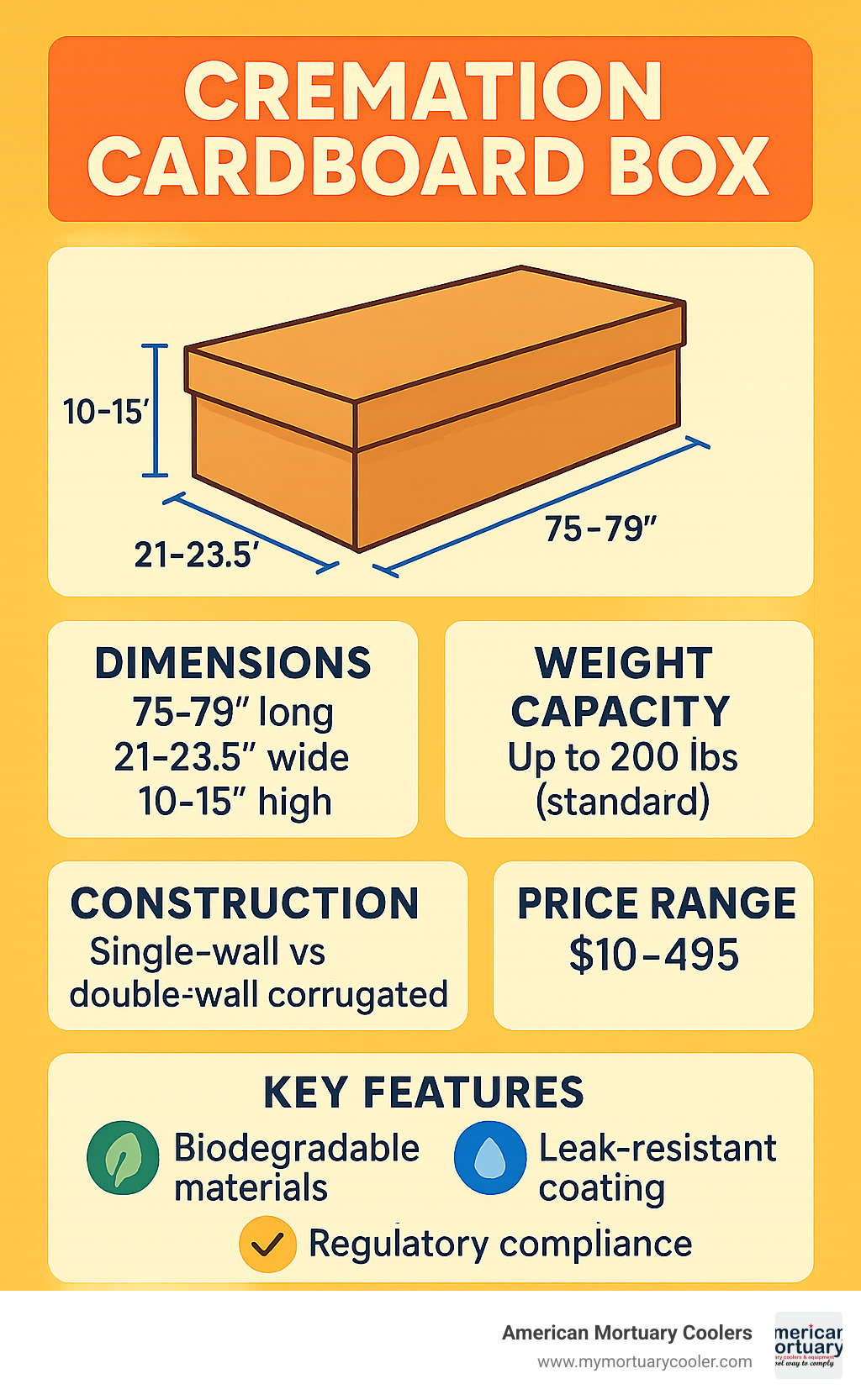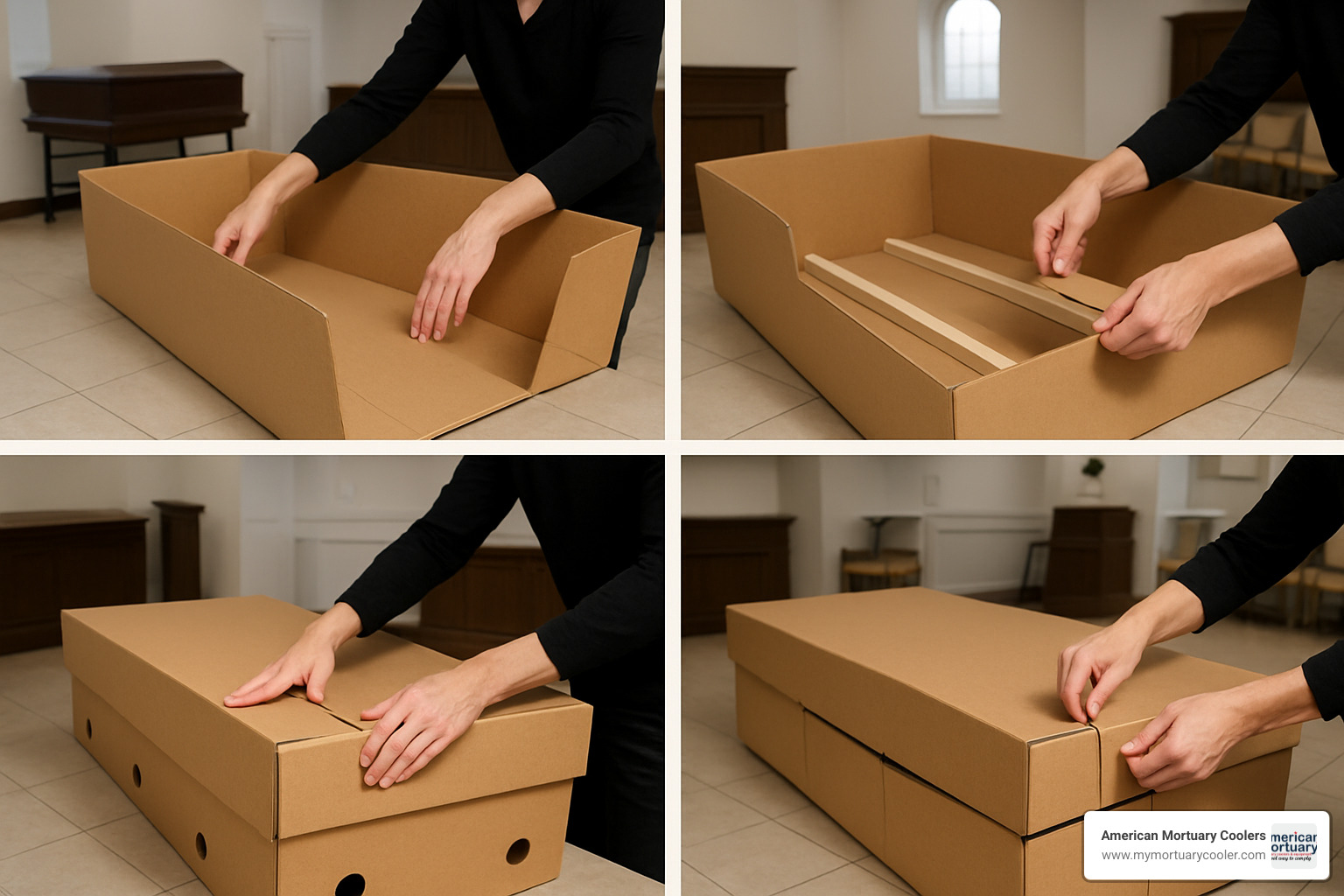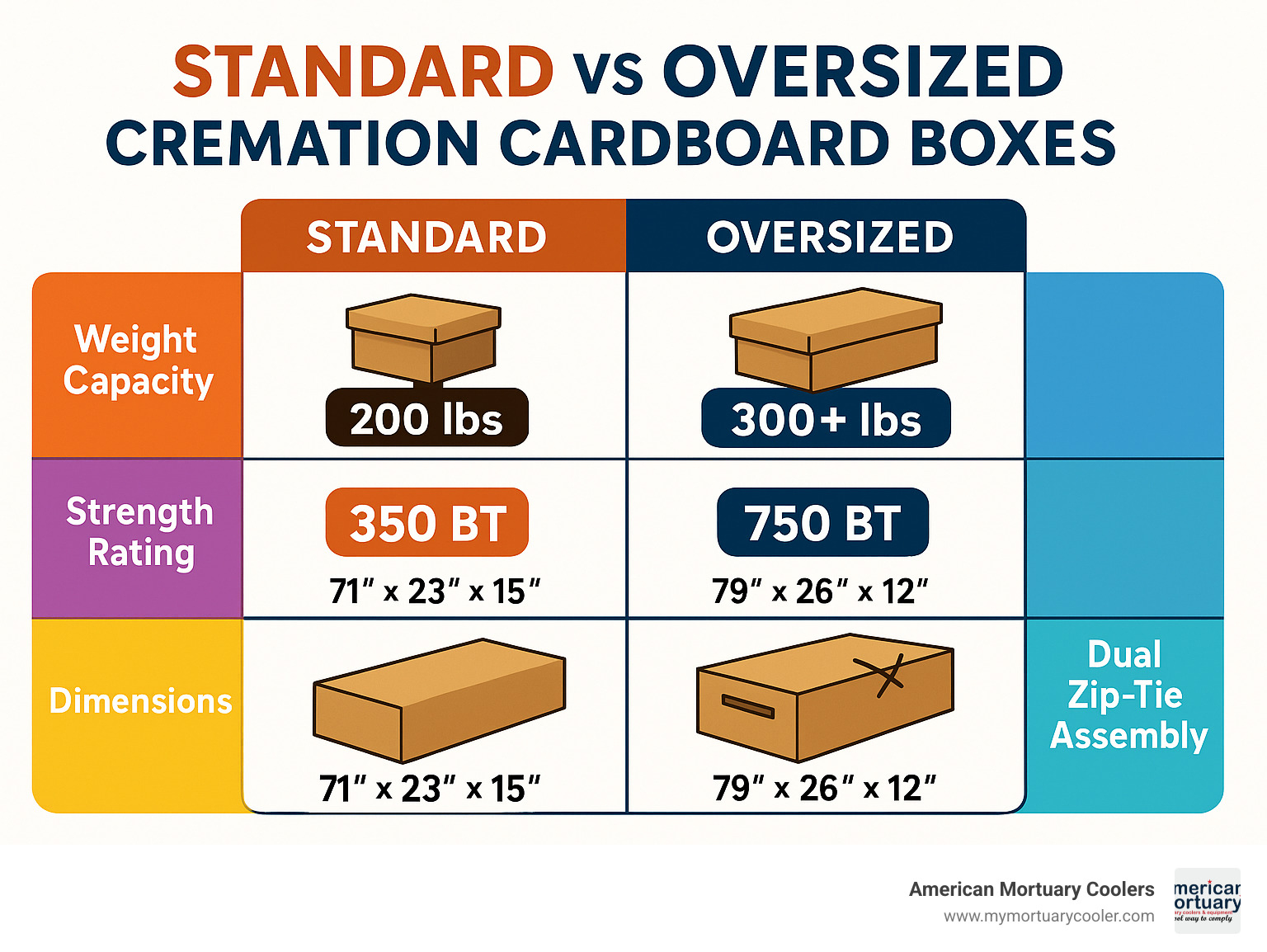Why Cremation Cardboard Boxes Are Essential for Modern Funeral Operations
A cremation cardboard box is a rigid container made from corrugated cardboard that serves as the primary enclosure for human remains during the cremation process. These eco-friendly containers have become the standard choice for funeral homes seeking cost-effective, legally compliant solutions.
Quick Overview of Cremation Cardboard Boxes:
- Primary Purpose: Legal enclosure for cremation (required by law in many regions)
- Standard Dimensions: 75-79" length × 21-23.5" width × 10-15" height
- Weight Capacity: Up to 200 lbs for standard boxes, oversized available for heavier remains
- Price Range: $10-$495 per unit depending on features and order quantity
- Construction: Single or double-wall corrugated cardboard with optional leak-resistant coating
- Minimum Orders: Typically 10-50 units for wholesale purchasing
The funeral industry has increasingly acceptd cardboard cremation containers as a sustainable alternative to traditional wood caskets. With prices starting as low as $10 per unit for bulk orders, these containers offer significant cost savings while meeting all regulatory requirements across North America and the UK.
Key advantages include:
- Biodegradable materials that support green burial practices
- Lightweight construction (12-25 lbs) for easier handling
- Flat-pack shipping to reduce freight costs
- Optional leak-resistant coatings for extended storage
As Mortuary Cooler, I've worked extensively with funeral homes nationwide to optimize their cremation operations and equipment selection. My experience in the mortuary industry has shown that choosing the right cremation cardboard box can significantly impact both operational efficiency and cost management for funeral directors.

Basic cremation cardboard box terms:
Cremation Cardboard Box Essentials
When you're working in the funeral industry, understanding cremation cardboard boxes isn't just helpful—it's essential. These containers need to meet strict legal requirements while making your daily operations smoother and more cost-effective.
Let's start with the basics. Most regions have what's called a "rigid-container law," which means you can't just wrap remains in a sheet and call it good. The deceased must be enclosed in a sturdy container for cremation. That's where cremation cardboard boxes come in as a practical, legal solution.
Standard sizing across North America follows pretty consistent measurements: you're looking at containers that are 75-79 inches long, 21-23.5 inches wide, and 10-15 inches high. These dimensions work for most adult cases, with a weight limit of 200 pounds for standard boxes.
But what happens when you need something bigger? Oversize options are available and can handle heavier individuals—some models are actually 70% stronger than standard boxes. On the other end of the spectrum, infant sizes are manufactured for smaller cases, ensuring you have appropriate options for every situation.
The regulatory landscape varies depending on where you operate. In British Columbia, the law specifically requires rigid containers for cremation. Similar rules exist across Canadian provinces and U.S. states, though the exact wording might differ. The UK has its own cremation regulations, but cardboard containers meet those standards too.
If you're helping families explore affordable options, Arrange Online Now cremation planning can guide them through these choices while keeping everything above board with local regulations.
Primary Purpose of a Cremation Cardboard Box
The cremation cardboard box does more heavy lifting than you might expect. Its primary purpose is straightforward: body enclosure during the cremation process. But it's also about maintaining dignity while meeting those legal requirements we talked about.
These containers have become the backbone of direct cremation services, which are growing in popularity because they're cost-effective and simple. No fuss, no complications—just what families need when they're dealing with loss.
From a practical standpoint, funeral home handling becomes much easier with these boxes. They provide the structural integrity you need while staying lightweight enough (typically 12-25 pounds) that your staff can manage them safely.
For families interested in green burial options, cardboard containers align perfectly with environmental values. They're biodegradable, which means they break down naturally without leaving a lasting impact on the earth.
Typical Dimensions for a Cremation Cardboard Box
Getting the dimensions right matters more than you might think. A cremation cardboard box needs to fit the person, your equipment, and the crematorium's requirements all at once.
The industry has settled on some standard measurements that work for most situations. Length typically runs 75-79 inches for standard adult sizes, while width stays between 21-23.5 inches. Height usually falls in the 10-15 inch range, and the tare weight (that's the empty box weight) runs 12-25 pounds depending on how it's built.
The 79×22×15-inch standard has become popular because it handles most adult cases while fitting standard crematorium equipment. These boxes are built to meet edge-crush test ratings of 51 ECT, which means they can handle normal transport and handling without falling apart.
When standard won't cut it, oversized options extend to 79×26×12 inches for larger individuals. These precise measurements aren't random—they ensure your containers will work with crematorium equipment and transport vehicles across different facilities, making your job easier and more predictable.
Construction, Strength & Eco Impact
When you're choosing a cremation cardboard box, understanding what goes into making these containers helps you pick the right one for your needs. The construction quality affects everything from how well they hold up during transport to their environmental impact.
Most cremation containers come in two main construction types. Single-wall corrugated cardboard works perfectly for immediate cremation needs - it's sturdy enough for the job while keeping costs down. Double-wall construction steps things up with extra durability, making it ideal when you need longer storage periods or have to transport remains over longer distances.
The real game-changer comes with specialized coatings. Premium models feature coatings like the Michelman liner system, which creates a leak-resistant barrier. These wax-coated versions are worth considering when you're dealing with extended storage or long-distance transport situations where extra protection matters.
Strength gets measured through two key tests that tell you exactly what a container can handle. The Burst Test (BT) measures how many pounds of pressure it takes to burst the cardboard - top-quality boxes can handle up to 750 BT. The Edge Crush Test (ECT) checks compression strength from top to bottom, with most cremation boxes rated at 51 ECT. These numbers might seem technical, but they translate to real-world reliability when you need it most.
From an environmental standpoint, cardboard containers are impressive. They use biodegradable glues and materials throughout, creating a much smaller carbon footprint compared to traditional wooden caskets. The corrugated kraft construction naturally breaks down when buried, making these containers perfect for families choosing green burial options.
The recycling aspect adds another environmental win - the materials can be recycled before use, and they decompose completely after cremation or burial. For funeral homes tracking their environmental impact, switching to cardboard containers makes a measurable difference.
For more detailed guidance on selecting the right container for your specific needs, check out our Click Here to View Our Consumer Information Guide.
| Material | Cost Range | Strength | Environmental Impact | Weight |
|---|---|---|---|---|
| Cardboard | $10-$495 | 350-750 BT | Fully biodegradable | 12-25 lbs |
| Wood | $840-$3,840 | High | Moderate (renewable) | 50-100 lbs |
| Particle Board | $345 | Medium | Low (synthetic binders) | 30-50 lbs |
The numbers in this comparison table show why cardboard has become so popular. You get solid performance at a fraction of the cost, with the added benefit of being the most environmentally responsible choice available.
Buying Guide: Costs, Variants & Regulations
Shopping for a cremation cardboard box can feel overwhelming with all the options and rules to consider. Let me walk you through what really matters when making your purchase decision.
The price range is pretty wide – you'll find basic models starting around $10 per unit when you buy in bulk, while premium leak-resistant containers can cost up to $495. Most suppliers want you to order at least 10 to 50 units at a time, but the bulk discounts make it worth your while if you can swing the larger orders.
You'll encounter three main types: standard boxes for everyday use, premium wax-coated models when you need extra protection, and oversized containers for larger individuals. Don't forget about infant boxes if you serve families with young children – these come in appropriately smaller sizes.
Many suppliers offer two-pack bundles that work well for busy funeral homes. The boxes usually ship folded flat to keep your freight costs down, which is a nice touch when you're watching the budget. You'll need to buy tie straps and zip-ties separately, which typically adds $5-15 per container.
Here's where it gets tricky – the rules change depending on where you operate. British Columbia has a rigid container law that makes cardboard boxes not just an option, but a requirement. U.S. Federal Trade Commission rules require you to offer alternative containers to families, making these boxes a smart compliance choice. The UK has similar guidelines under their Cremation Act.
For more detailed guidance on selecting the right container for your needs, check out More info about choosing boxes.
Standard, Premium & Oversized Choices
When you're choosing a cremation cardboard box, think of it like picking the right tool for the job. Each type serves a specific purpose, and understanding the differences will save you headaches down the road.
Standard boxes are your workhorses. They measure about 74.5×21.75×10 inches and feature single-wall construction with 350 BT strength ratings. These are perfect when you need a reliable container for immediate cremation and don't require extended storage. They get the job done without breaking the budget.
Premium models step things up with leak-resistant wax coatings and reinforced construction. The Michelman interior coating provides fluid containment that gives you peace of mind during transport or storage. These containers boast 750 BT strength ratings and dual zip-tie assembly systems. They're worth the extra cost when you're dealing with longer storage periods or transport requirements.
Oversized containers are lifesavers when you're serving families with loved ones over 200 pounds. These measure 79×26×12 inches and are 70% stronger than standard boxes. The reinforced floors include internal wood strips for extra support, ensuring safe handling throughout the entire cremation process.
Cost Factors & Wholesale Purchasing
Understanding the real cost of your cremation cardboard box purchase goes beyond just looking at the unit price. Several factors can significantly impact your bottom line.
Unit pricing starts at around $60 for basic unlined containers, while premium leak-resistant boxes can reach $495. The good news is that volume discounts kick in at 50, 100, and 200+ unit levels, often saving you 15-30% on larger orders. If you can plan ahead and order in bulk, the savings really add up.
Shipping costs deserve careful attention since most containers ship folded flat to minimize freight expenses. Suppliers typically pack 8 boxes per corrugated outer, which helps keep shipping reasonable. However, delivery fees like the $30 charge for Greater Toronto Area delivery need to factor into your budget calculations.
That most suppliers only sell to licensed funeral homes, cemeteries, crematories, and medical schools. This professional-only sales approach ensures proper handling and maintains industry pricing structures, but it means you'll need proper credentials to make purchases.
Region-Specific Regulations
Navigating cremation cardboard box regulations can feel like walking through a maze, especially if you operate in multiple areas. Each jurisdiction has its own rules, and staying compliant is crucial for your business.
British Columbia takes a firm stance – they explicitly require rigid containers for cremation, and cardboard boxes perfectly meet this legal standard. Other Canadian provinces have similar requirements, though the specific details might vary slightly from place to place.
U.S. state cremation codes generally require appropriate containment without getting too specific about materials. This gives you flexibility in choosing cardboard containers. The Federal Trade Commission's Funeral Rule actually works in your favor here – it requires funeral homes to offer alternative containers to families, making cardboard boxes an ideal compliance solution.
UK regulations under the Cremation Act mandate suitable containment for cremation, and cardboard containers easily meet these requirements. If you're dealing with airline transport of remains, additional regulations might apply regarding container construction and labeling requirements.
The key is knowing your local rules and keeping documentation handy. When in doubt, check with your local regulatory authority – it's better to ask questions upfront than deal with compliance issues later.
Assembly, Transport & Storage
Proper handling of cremation cardboard boxes requires understanding assembly procedures, transport protocols, and storage requirements. Our experience supporting funeral operations across regions like Dallas, Chicago, and Los Angeles has highlighted critical best practices.

Most containers arrive as flat-pack units to minimize shipping costs and storage space. The assembly process involves folding along pre-scored lines and securing with tape, straps, or zip-ties depending on the model. Wood strips are often included for floor reinforcement, particularly in oversized models.
Safe transport requires attention to weight distribution and securing methods. Body weight should be evenly distributed, and proper gurney transfer techniques prevent structural stress. For refrigerated storage, wax-coated models provide better moisture resistance during extended cool room storage periods.
Crematorium loading procedures must account for the container's construction. While cardboard boxes are designed for cremation, proper positioning and handling ensure safe transfer into cremation equipment.
For additional guidance on cremation container handling, see More info about cremation container handling.
Step-by-Step Assembly Guide
Assembling a cremation cardboard box requires following specific procedures to ensure structural integrity and safety:
- Unpack the flat container and identify pre-scored fold lines
- Fold the base along marked creases, ensuring corners align properly
- Install wood strips (if included) along the floor for reinforcement
- Secure the base using tape, zip-ties, or straps as specified
- Position the lid ensuring proper alignment with base edges
- Label the container with required identification information
The assembly process typically takes 3-5 minutes per container. Premium models with dual zip-tie systems require additional time but provide improved security. Proper technique prevents structural weakening that could compromise safety during handling.
Safe Transport & Short-Term Storage
Cremation cardboard box transport requires attention to weight limits and handling procedures. Standard boxes accommodate up to 200 lbs, while oversized models handle heavier remains safely.
Weight distribution is critical during gurney transfer. Uneven loading can stress container joints, potentially causing structural failure. Two-person lifting is recommended for all transfers, regardless of container size.
Cool room storage benefits from wax-coated containers when delays occur. The leak-resistant coating prevents moisture absorption that could weaken cardboard construction. Storage duration should be minimized, as even premium containers aren't designed for long-term storage.
Vehicle loading requires securing containers to prevent shifting during transport. Proper restraint systems protect both the remains and transport personnel from potential accidents.
Frequently Asked Questions
1. Are cremation cardboard boxes legally required?
Yes, in many jurisdictions including British Columbia, rigid containers are legally required for cremation. Cremation cardboard boxes meet these requirements while providing cost-effective compliance. However, specific regulations vary by region, so funeral directors should verify local requirements.
2. Can families personalize the box?
Limited personalization options exist through programs like the Living Memorial® Program, which allows custom imprints on cardboard containers. However, most basic models don't support extensive customization due to their temporary nature and cremation purpose.
3. What if the deceased exceeds 200 lbs?
Oversized cremation cardboard boxes are available for individuals over 200 lbs, with dimensions up to 79×26×12 inches. These containers are 70% stronger than standard models and include reinforced construction with wood strip flooring for additional support.

Conclusion
Choosing the right cremation cardboard box can transform how your funeral home operates. These containers deliver real environmental benefits while keeping costs manageable and ensuring you meet all regulatory requirements with confidence.
The numbers speak for themselves. With prices starting at just $10 for bulk orders and reaching $495 for premium leak-resistant models, you have the flexibility to match each container to your specific needs and budget. The lightweight design (12-25 lbs) makes handling easier for your staff, while flat-pack shipping keeps your freight costs low compared to bulky wooden alternatives.
Compliance doesn't have to be complicated. Whether you're working under British Columbia's rigid container requirements, navigating U.S. Federal Trade Commission rules, or following UK Cremation Act guidelines, cardboard containers provide a straightforward solution that works across jurisdictions.
Your families increasingly care about environmental impact, and cremation cardboard boxes align perfectly with these values. The biodegradable materials and reduced carbon footprint demonstrate your commitment to sustainable practices without compromising the dignity and respect that every service requires.
At American Mortuary Coolers, we know that efficient cremation operations need more than just containers. They need comprehensive equipment solutions that work together seamlessly. Our custom mortuary coolers provide the proper storage and handling capabilities that complement your cremation services, with direct delivery across all 48 contiguous states.
The funeral industry is moving toward solutions that are both sustainable and practical. Cremation cardboard boxes represent exactly this kind of forward-thinking approach – they save money, protect the environment, and maintain the professional standards your families expect.
For comprehensive mortuary equipment solutions that complement your cremation services, explore More info about mortuary cooler solutions.


















